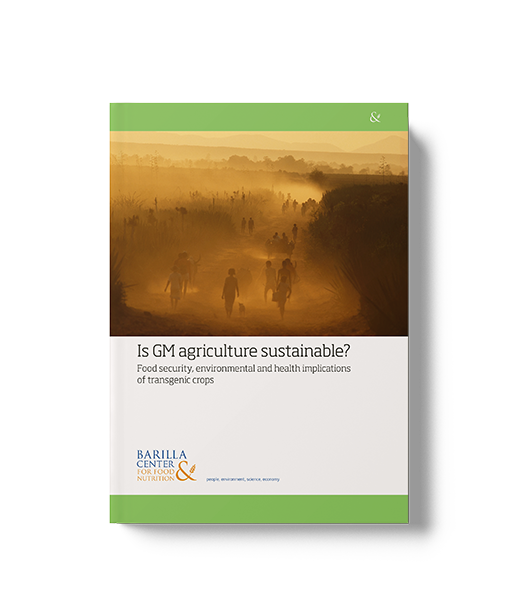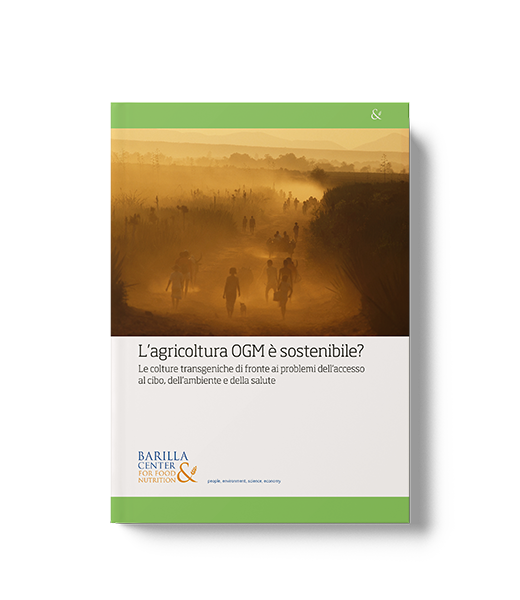
Barilla Center for Food & Nutrition
Is GM agriculture sustainable?
Barilla Center for Food & Nutrition
Scaricato 256 volte
The question the BCFN seeks to answer is to what extent the extraordinary advancements in knowledge—which in recent decades have made it possible to intervene in the genetic makeup of plants—can provide sustainable (i.e., lasting) solutions to the major issues on which its work is focused: food security (food for all), the environment (sustainable development), health (food for health), and lifestyles (food for culture).
The topic of biotechnologies in the agri-food sector is by its nature cross-cutting, and as such, can only be fully understood from a multidisciplinary perspective. For this reason, it was decided to seek answers to the following questions:
• can GMOs offer an effective and lasting solution to the problems of food access around the world? Or, on the contrary, do they risk increasing inequalities?;
• can GMOs help address and solve issues of environmental sustainability and the scarcity of natural resources? Or do they instead pose a threat to biodiversity?;
• are there risks associated with the consumption of genetically modified foods currently on the market?;
• what are people’s perceptions of biotechnologies and GMOs? And how is the topic portrayed in the media?.
The analysis aimed to integrate different perspectives to arrive at a summary judgment that is nonetheless nuanced, based on the representation of contrasting viewpoints and the facts that support them.
The goal is to understand and illustrate the current state of the art regarding the role of GMOs in the agri-food sector: the problems, possible solutions, prevailing opinions, and evaluations.
Executive summary
1. Why another position paper dedicated on GMOs?
1.1 Biotechnologies and their applications in the agro-food sector
1.2 What are the questions we tried to answer?
1.3 Methodology and structure of the analysis
2. Biotechnologies in the agro-food sector: developments and applications
2.1 The birth of biotechnologies and their development so far
2.2 Biotechnologies in the agro-food sector and GMOs
2.3 What GMOs, now and in the future?
2.4 The existing commercial products
2.5 The producing Countries
3. The answers to the questions of the Barilla Center for Food and Nutrition
3.1. Are there health risks tied to eating genetically modified ingredients currently on the market?
3.1.1 Is the testing and approval system appropriate?
3.1.2 Did any health damage occur as a result of the consumption of genetically modified foods?
3.1.3 Can now unknown health effects occur in the long term?
3.1.4 Are any efforts currently under way to obtain genetically modified foods with a role in disease prevention?
3.1.5 Summary remarks on the Health Area
3.2. Can GMOs help address and solve the issues of environmental sustainability and shortage of natural resources? Or do they rather pose a threat to biodiversity?
3.2.1 Can GMOs contribute to tackling and solving problems associated with environmental sustainability and the shortage of natural resources?
3.2.2 What is the impact of the extensive single-culture GM farming model on the environment?
3.2.3 Can the use of GMOs generate negative impacts on the natural habitat of insects and wildlife?
3.2.4 Does the use of GMOs decrease the use of pesticides, also considering the risk of onset of resistance?
3.2.5 What are the risks of possible contaminations between GM and conventional plants?
3.2.6 Summary remarks on the Environment Area
3.3.1 Do GMOs allow to achieve clear, significant, and persistent productivity gains?
3.3.2 Can GMOs provide a response to farming problems in developing Countries?
3.3.3 Are there any critical issues linked to the structure of the sector and the business models adopted by companies?
3.3.4 Summary remarks on the Food Security Area
3.4. What do people think about GMOs?
3.4.1 What is people’s experience of GMOs?
3.4.2 How is the topic of GMOs covered by the media?
3.4.3 Summary remarks on the Culture and Media Area
4. Synthesis scheme and next steps
Appendix: media and GMO
Bibliography
Il Barilla Center for Food & Nutrition (BCFN) è un think tank multidisciplinare fondato nel 2009 all’interno della Fondazione Barilla e trasformato in fondazione autonoma nel 2014, con l’obiettivo di raccogliere e analizzare conoscenze sulla filiera alimentare per proporre soluzioni sostenibili e salutari. Con sede a Parma e finanziato dal Gruppo Barilla, riunisce esperti in nutrizione, economia, scienze ambientali e sociologia per studiare le dinamiche di produzione, consumo e spreco alimentare.
Organizza eventi internazionali, tra cui il BCFN Forum, workshop e webinar, coinvolgendo istituzioni, università e ONG in partnership strategiche. Offre programmi di formazione e comunicazione, webinar e risorse online per sensibilizzare consumatori e operatori del settore sulle sfide nutrizionali e ambientali. Grazie a collaborazioni con FAO, IFAD e altre agenzie internazionali, il BCFN contribuisce a definire linee guida e policy per una dieta sana, equa e rispettosa del pianeta.
